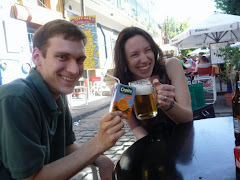On Friday my 12th grade class invited me to celebrate Tsaraton with them. It's a folk holiday whose origins are vague but seem to be connected with 7 martyrs killed on a mountaintop. On this day, pregnant women aren't allowed to do work (especially not work with knives or running water), and others climb to the top of the hill called Tavshanka outside of town, where stand 7 stone shrines (and a cellphone tower). They light candles and fires at the shrines, gather a kind of yellow primrose that is always just blooming around that time, and share a picnic lunch around a fire.
I forgot to bring my camera with me, but that's just as well, as we were soaked clear through by the time we made it to the top. We'll have pictures for you all next year. (And, I presume the 7,000 photos taken of me by the 12th graders will pop up on Facebook or its Russian counterpart).
I did bring my guitar, at the students' request, and played a little after we'd taken shelter under the pine trees that grow on half the hill. The kids lit a fire (in a fashion that would have rather displeased Smokey Bear), and we dried off a bit by it and had some cheese and sausage sandwiches, chicken, cucumber and tomato salad, and cookies. The kids then sang some patriotic songs, and, the rain again starting to soak us through, we headed home.
Bad weather can never really spoil good company. And the holiday itself was really interesting, feeling, like some of the other folk holidays and traditions I've seen, really very old, somehow existing outside the history of established saints' days or Federal Holidays or the kinds of things you go to Hallmark for.
A glutton for punishment, I took the rainy Sunday to meet up with fellow volunteer Christopher in Ninotsminda and hopped a taxi to the village of Gorelovka a few miles away, to see what we could see of the Doukhobors, a Russian sect of spiritualist Christians with very particular beliefs, traditions, and ways of life - they are pacifists, anarchists, and vegetarians. There's a large and well-known Doukhobor community in Canada, which is why I had only heard of them in a song by the Band.
Others, exiled to Georgia in the 19th century, made their home in Gorelovka, and we went to visit what we had been told was a sort of house-church-museum open to the public, the home of the former leaders of the Gorelovka Doukhobors, the Kalmykovs.
We got to the house in the rain, directed by some local kids who gave us conflicting information about how "open" it was, and met two old women in traditional dress - bright pink and purple skirts, embroidered vests, and white headscarves. They greeted us and invited us in to a big concrete common room with benches along the walls, saying the others would be coming soon. Not sure what to make of all this, we asked to take a quick look around the grounds.

Church/worship space

Meeting house
Probably the most distinctive aspect of Doukhobor architecture in Georgia is their sod roofs. A man told us that the tradition comes from the early days of their exile, when they had to survive their first winter with almost no building materials or resources. He said that they lived almost in tunnels the first winter, and afterward built houses and roofed them with the available mud and grass. He vouched for their efficacy in keeping the building warm in winter and cool in summer.
All the other doors in the complex were locked, and we retreated to the common room and waited. After a little while we heard a kind of singing chant, and a group of 9 women in traditional dress and 2 men arrived. They sang, bowed to the house, prayed, and recited from the Bible, then invited us inside.

Turns out, we had come on a holiday - the second Sunday after Easter, when the community finishes eating the eggs and cake made for the Easter feast and gives anything remaining to the poor. We walked into the dining hall through the left of two doors (the women went through the right), and they sang and prayed before sitting down to dyed Easter eggs, dry cake, and juice. We talked a little about their history, culture, and traditions, but we were feeling a little bit like intruders, there being no "museum" section in sight. Eventually we finished the meal, more song and prayer, a little conversation with one of the guys, and then the crowd dispersed, and we with them.
Awkwardness of the visit notwithstanding, it was probably a more valuable experience than shuffling around a museum, since we got to meet the people, hear the songs and prayers, and break bread together. I hope we didn't put too much of a damper on their holiday, but maybe crashing the "eat up the 2-week old leftovers before we give them away" holiday isn't quite the imposition that showing up at a family Thanksgiving might be.
And, though the house (and rumored museum) might remain, there might not be a long time left to meet Doukhobors in Georgia. The community is small and shrinking, many of the young people emigrating to Russia after the fall of the Soviet Union, and, for the most part, only the older generation remaining. So it was good to see the ones who have stayed coming and singing on a rainy Sunday, watching the old women crack their Easter eggs against each others', and talking (if only a little) with people kind enough to invite a couple of foreign strangers into their home for a holiday meal.




Wow! You do have some interesting experiences, Sam. You should write a book. However, don't try to use Climber the cat as a main character, I have exclusive rights to her!!!
ReplyDelete